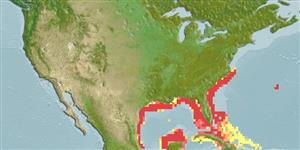Common names from other countries
Environment: milieu / climate zone / depth range / distribution range
Ecologia
marinhas demersal; intervalo de profundidade 19 - 130 m (Ref. 26938). Subtropical; 37°N - 7°N, 98°W - 59°W
Western Atlantic: North Carolina to southern Florida, USA, northern Bahamas, Gulf of Mexico, Caribbean Sea, Colombia to Trinidad and Tobago.
Tamanho / Peso / Idade
Maturity: Lm ? range ? - ? cm
Max length : 71.0 cm TL macho/indeterminado; (Ref. 26938); common length : 35.0 cm TL macho/indeterminado; (Ref. 3275); peso máx. Publicado: 2.8 kg (Ref. 40637)
Occurs in bays, lagoons and shallow coastal waters (Ref. 7251). Inhabits mainly hard and sandy bottoms (Ref. 3275).
Life cycle and mating behavior
Maturities | Reprodução | Spawnings | Egg(s) | Fecundities | Larvas
Distinct pairing (Ref. 205).
Robins, C.R. and G.C. Ray, 1986. A field guide to Atlantic coast fishes of North America. Houghton Mifflin Company, Boston, U.S.A. 354 p. (Ref. 7251)
Categoria na Lista Vermelha da IUCN (Ref. 130435)
CITES (Ref. 128078)
Not Evaluated
Ameaça para o homem
Harmless
Utilização humana
Pescarias: pouco comercial
Ferramentas
Relatórios especiais
Descarregue XML
Fontes da internet
Estimates based on models
Preferred temperature (Ref.
115969): 21.1 - 27.5, mean 24.2 (based on 84 cells).
Phylogenetic diversity index (Ref.
82804): PD
50 = 0.5000 [Uniqueness, from 0.5 = low to 2.0 = high].
Bayesian length-weight: a=0.00646 (0.00290 - 0.01435), b=3.17 (2.99 - 3.35), in cm Total Length, based on LWR estimates for this Genus-body shape (Ref.
93245).
Nível Trófico (Ref.
69278): 4.3 ±0.6 se; based on size and trophs of closest relatives
Resiliência (Ref.
120179): Médio, tempo mínimo de duplicação da população 1,4 - 4,4 anos (Preliminary K or Fecundity.).
Fishing Vulnerability (Ref.
59153): Moderate to high vulnerability (48 of 100).
